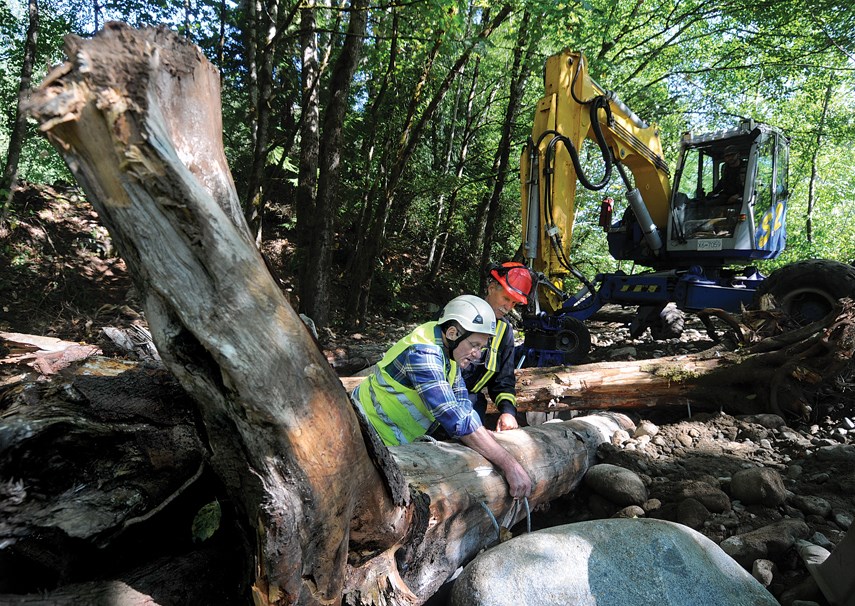Building a watery nursery for young coho salmon is no small task.
It took 120 large boulders, 34 logs, a specialized excavator and countless hours of work by dedicated volunteers.
But for Glen Parker, project manager for the North Shore Streamkeepers, recent work to restore habitat for juvenile coho in a natural channel of Lynn Creek is worth the effort.
If the project is successful, it could increase the number of coho returning to Lynn Creek each year from the hundreds to the thousands, said Parker.
“It’s one of the bigger restoration projects that has been done on the North Shore in a while.”
The restoration project has been a long time coming.
Lynn Creek, the third largest salmon-bearing river on the North Shore, is a fabulous river for fish, said Parker – it’s cool and well-aerated – just the type of water salmon love.
But like many urban rivers, Lynn Creek has been “heavily armoured” with rocks and reinforcements along its sides to protect nearby land against flooding. For young coho, that’s bad news, said Parker, because those reinforcements also tend to destroy smaller back channels that are essential for the juvenile salmon. Unlike some other salmon species, young coho spend a year in the river before heading out to the sea.
Smaller channels and pools give the fish a more protected environment as they mature, said Parker.
The work will also help the buffer the salmon from impacts of climate change which can include large floods in winter and drier-than-normal conditions in summer, he added.
Several reports have pointed to the need for work on a Lynn Creek channel over recent decades, said Parker. But it was Port of Vancouver staff who pointed that out to the local streamkeepers. The port also provided the lion’s share of funding to get initial engineering work done on the project.
That was essential, said Parker, because the project had to be built to withstand the force of a serious flood that might happen only once in 200 years – ensuring that rocks and boulders in the channel won’t come loose and be carried downstream.
Essentially the project involved creating four “pools” in the natural channel – each about four metres in diameter – with the use of logs and boulders.
Boulders and logs were moved into place with a spider excavator capable of picking up and placing five-tonne rocks “with the precision of doing needlework,” said Parker.
To ensure the logs don’t move, each of them had to be held down with four boulders, attached with cables. “They’ll be there for hopefully a long time,” said Parker.
The total cost of the project was about $100,000. Of that, almost half was contributed by “in-kind” donations of goods and volunteer labour. The Port of Vancouver was the largest cash donor while the Pacific Salmon Foundation also contributed a significant sum. Logs and boulders were donated by the Tsleil-Waututh Nation. Northwest Hydraulic Consultants were also instrumental to the project, said Parker.
Work in the river – about half a kilometre upstream from where Highway 1 crosses the creek at the bottom of the Cut – started Aug. 21 and wrapped up Monday.
The work in the channel should help both the natural coho population and salmon enhancement efforts by the Morton Creek hatchery upstream, which also releases a small number of young coho into the creek, said Parker.
“If they have good places to live they have a better chance of survival.”



